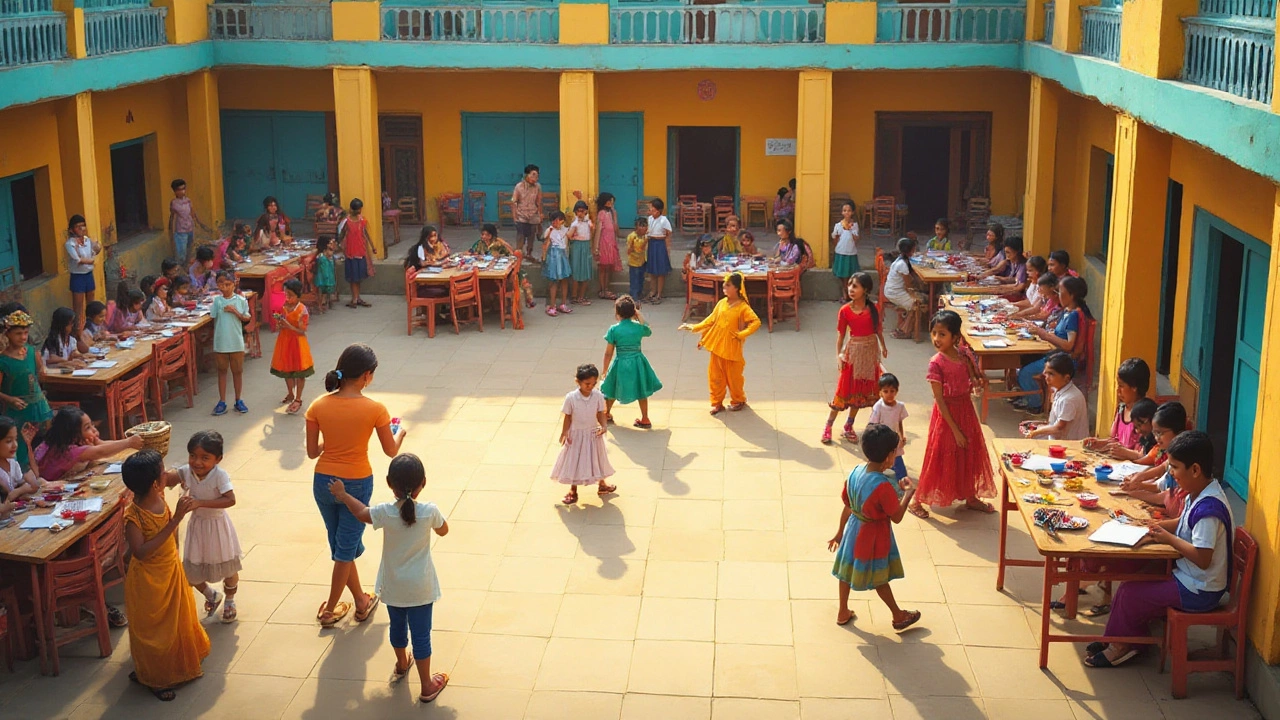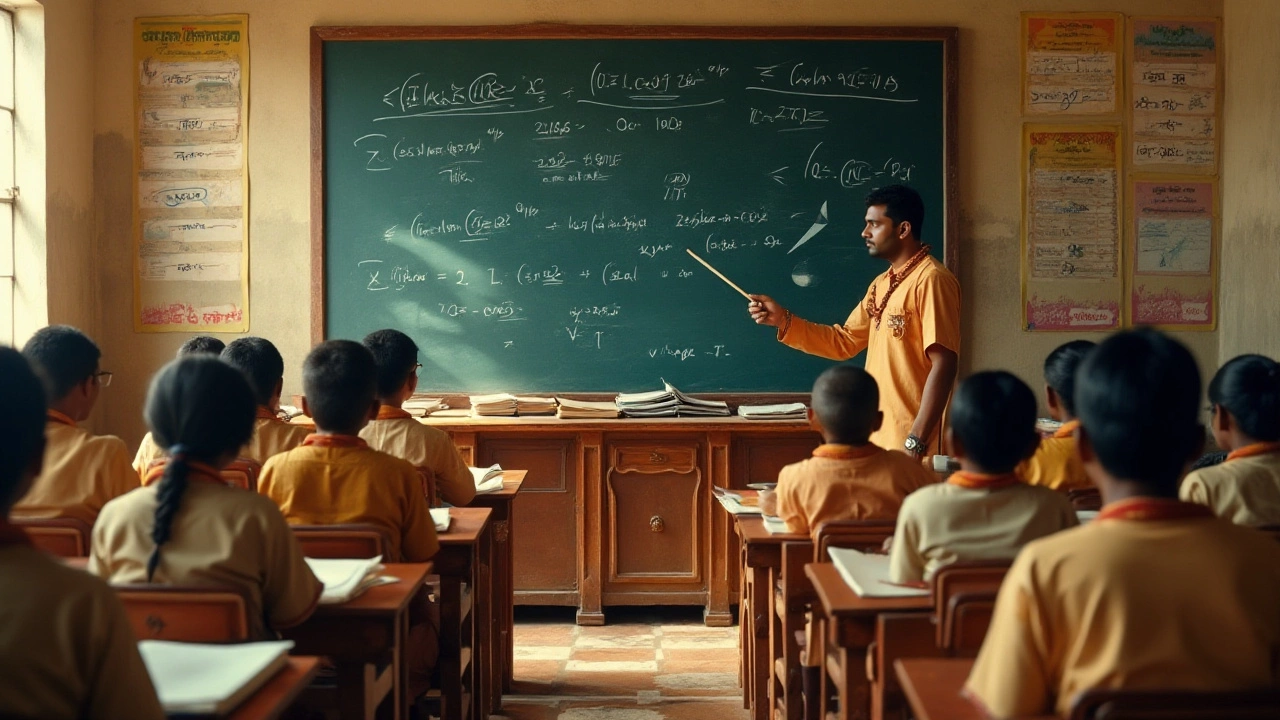Comparing education systems is never an easy task, especially when the conversation centers around two vastly different countries like the USA and India. In this article, we focus on the Central Board of Secondary Education (CBSE) syllabus, a predominant curriculum in India, to explore how it stacks up against the American educational framework.
Each system has its unique strengths and challenges, often shaped by cultural, societal, and economic factors. While the US places a strong emphasis on creativity, individuality, and skills applicable to a modern workforce, India leans into deep-rooted traditions that stress academic excellence and theoretical understanding.
Understanding these dynamics is crucial, especially for those making decisions about education and seeking the best options for their children's future. So, let’s unravel the intricacies of what makes these two educational landscapes both compelling and distinct.
- Overview of Education Systems
- Teaching Methodologies and Classroom Environment
- Curriculum and Academic Outcomes
- Role of Extracurricular Activities
- Parental and Student Perspectives
Overview of Education Systems
Education systems in the USA and India are shaped by their respective cultural, social, and economic landscapes. Both countries aim to provide quality education but take distinct approaches. In the USA, the system encourages creativity, critical thinking, and flexibility, with a variety of schooling options including public, private, and charter schools. From a young age, students are prompted to be independent thinkers, often choosing from a plethora of elective subjects that cater to diverse interests early on. It’s a system known for its broad and inclusive nature, allowing students to tailor education to personal interests and aspirations, often at the local school level.
The Indian education system, notably with the Central Board of Secondary Education (CBSE syllabus), tends to emphasize theoretical knowledge and academic rigor over practical skills. Here, the focus is on core subjects like mathematics and sciences, stressing discipline and a structured approach. This traditional system is known for producing students with strong subject matter expertise, often reflected in competitive examinations and global academic competitions. Yet, it can sometimes lack encouragement for creativity and critical thinking, elements that frequently define the American educational experience.
A distinctive feature in the comparison of these systems is the duration and content of school years. For example, in the US, the school year typically spans early September to June of the following year, incorporating breaks such as summer and winter holidays. Students move through grades rather fluidly, transitioning from foundational knowledge in primary schools to more specialized courses in high school. The US employs a credit system that adds further customization, ultimately preparing students for college or vocational choices.
In contrast, India's academic year generally aligns with the calendar year, often starting in April and ending in March, with similar breaks interspersed. Despite a rigid curriculum, recent reforms in India aim to incorporate a more holistic approach with added value-based components, hands-on learning, and life skills education. In many respects, Indian education has started to evolve, pushing beyond conventional boundaries to include creative outlets and entrepreneurial spirits among students. Notably, a survey by the National Sample Survey Office (NSSO) indicated a gradual increase in digital education initiatives, though accessibility remains uneven across different regions.
To-do, education is a critical component for both nations in developing future talent. Each system has its merits and is often subjected to necessary reform. While the US continues to wrestle with issues such as educational equity and standardized testing controversies, India grapples with problems of access, infrastructure, and the integration of technology into classrooms. Adapting and evolving are key to addressing the educational demands of this century, all the while balancing the heritage and expectation rooted deeply within these systems. Perhaps the essence of a successful education framework, wherever it is applied, lies in its ability to persevere through times of change and uncertainty, equipping students with optimism and resilience for the future.
Teaching Methodologies and Classroom Environment
The teaching methodologies in the USA and India differ widely, shaped by historical and cultural narratives. American classrooms often prioritize student-centered learning, encouraging open discussions, critical thinking, and exploration. This approach creates an engaging classroom environment where students are motivated to ask questions and express their thoughts. Teachers act as facilitators, guiding students through the educational process rather than dictating every step. In contrast, the traditional Indian classroom places a greater emphasis on teacher-centered learning. Here, the lecturer is the main source of knowledge, and students are primarily focused on note-taking and memorization. The discipline is often stricter, and the emphasis lies heavily on academic performance measured through exams.
Despite these broad strokes, there have been significant strides in adapting CBSE syllabus and pedagogical techniques in India to include more interactive and student-friendly practices. Schools are increasingly incorporating technology into learning, making lessons more interactive with smart boards and digital resources. The shift is moving towards creating a more holistic environment where creativity and practical application are encouraged alongside traditional values of discipline and hard work. This reflects a global trend towards balancing the scales between rote learning and experiential understanding, which is essential in developing critical thinking skills.
Classroom settings in the USA often reflect a more informal atmosphere. Desks might be arranged in clusters, making it easy for students to collaborate. Group projects and presentations are regular features of the American schooling experience. In contrast, most Indian schools, particularly those adhering to the CBSE syllabus, follow the traditional structure of rows or columns. This is slowly changing, but the transition requires time and resources, which may not be readily available in all schools.
According to the National Center for Education Statistics, "In 2023, about 58% of U.S. teachers reported adapting their curriculum to suit the diverse learning needs of their students." This adaptability is less pronounced in India, although efforts are underway to foster inclusivity and personalized learning.
The environment deeply impacts the learning experience and outcomes for students. In the USA, the fluid atmosphere allows for easy adaptation to changes in educational trends, such as integrating more project-based learning or incorporating social-emotional skills. Such developments can enhance students’ relational and communicative skills, preparing them not just for exams, but for life. On the other hand, Indian classrooms traditionally focus on completing the stipulated syllabus rigorously, with assessments often driving the teaching pace. There is a strong commitment to the subject matter, aiming to nurture academic rigor, but it sometimes risks stifling creativity.
Innovative educators on both sides are continually rethinking the balance of these methodologies to better serve the diverse student populations they cater to. In India, the rise of international schools and the adoption of elements from global educational paradigms indicate a significant shift. But the essence of each system remains rooted in its foundational beliefs about what education should achieve. Understanding these differences in teaching methodologies and classroom environments offers meaningful insights for anyone navigating these educational landscapes.

Curriculum and Academic Outcomes
Unpacking the distinction between the curricula of the USA and India provides a fascinating look into two different educational mindsets. The CBSE syllabus in India is structured in a way that prioritizes foundational knowledge in subjects like mathematics, sciences, and social studies. This approach often results in a more rigorous rote learning experience, requiring students to memorize and reproduce information for examinations. The aim here is to lay a solid foundation that students can build upon, a strategy that has produced some of the world's most proficient professionals. In contrast, the United States educational system emphasizes critical thinking and problem-solving through a dynamic curriculum. Here, students are encouraged to apply what they learn across disciplines, which often involves collaborative projects and presentations.
The differences in these educational paradigms don't end there. In the United States, courses are frequently updated and reflect current societal, technological, and scientific trends. Schools have the autonomy to offer elective courses, which allow students to explore various interests and discover potential career paths. On the other hand, the CBSE curriculum is more standardized, with a nationally-mandated syllabus aimed at equipping students with uniform knowledge across the country. There’s an art to striking the balance between maintaining the robustness of core subjects and integrating new content—a challenge that educators face worldwide.
Academic outcomes often differ as a result of these approaches. In India, the focus through CBSE on a standardized examination determines students' future academic paths, leading to highly competitive entrance exams for further education. It's not uncommon for students to spend a significant portion of their schooling years preparing for these exams. Conversely, the outcome in the USA often involves a broader assessment of a student's capabilities. Grades, standardized tests, extracurricular involvement, and personal essays are components that universities consider for admissions, which might reduce but also broaden the pressure on students. As Jim Collins, an educator, once mentioned in an article I read,
"The ultimate goal of education should be to ignite a lifelong passion for learning, rather than short-lived academic achievement."
It's also interesting to examine how these systems perform in global education metrics. The Programme for International Student Assessment (PISA), which evaluates educational systems worldwide by testing the skills and knowledge of 15-year-olds, often shows varied results. Indian students have shown remarkable performances in theoretical subjects, while American students demonstrate strengths in creative and analytical tasks. The numbers, while illustrative, reflect broader educational philosophies rather than isolated strengths or weaknesses.
In determining which system might be 'better,' one must consider what they value more in education—whether it's a robust theoretical framework that equips students for specific competitive exams or an adaptable education that emphasizes creativity and holistic development. Different children thrive in different environments, making it crucial for parents and educators to understand these inherent differences before making educational decisions. Whether in India or the USA, the primary goal remains the same: to nurture an environment that fosters growth, curiosity, and the joy of learning.
Role of Extracurricular Activities
Extracurricular activities have long played a vital part in shaping a student's educational journey, acting as a bridge between academics and personal development. In the USA, the approach to extracurriculars is highly integrated and often considered as important as formal classroom instruction. Schools across the country offer a wide range of activities, from sports and music to robotics and debate clubs. These activities provide students the opportunity to discover passions, develop leadership skills, and learn the importance of teamwork and resilience.
In India, particularly under the CBSE syllabus, extracurricular activities are gaining momentum, yet the availability and diversity can vary significantly across schools and regions. Traditionally, the emphasis has been overwhelmingly on academic performance, but there is a growing recognition of the value that activities outside the textbook contribute to a well-rounded education. Schools are gradually incorporating more arts, sports, and technology programs, aiming to prepare students not merely for exams but for the real-world challenges they will inevitably face.
The truth is, the role of extracurricular activities extends beyond the student’s time in school. They often spark interests that influence career choices and even contribute to network-building skills. A recent study noted that students involved in extracurriculars show improved academic performance, better social skills, and higher levels of self-esteem. This cultural investment into their development can balance competitive pressure and foster a genuinely fulfilling educational experience.
"Participation in extracurricular activities can boost a student’s performance academically," asserts Dr. John Harrell, an educator and researcher in student development, highlighting the dual value of strength in academics and extracurriculars.
Schooling in India, although different in its prioritization and execution, is catching on to this dual track of development. Many educational boards and authorities recognize that these activities are not merely fillers but essential in cultivating talents that pure academics might overlook. Different schools across India are now striving to provide comprehensive programs that encourage creativity, critical thinking, and communication skills, aiming to match global educational standards set by counterparts like the USA. It's a path many are eager to follow, ensuring their educational framework is diverse, holistic, and conducive to all facets of a student’s personal and professional growth.

Parental and Student Perspectives
When we talk about education, understanding the thoughts and feelings of both parents and students is crucial. Parents often hold specific expectations based on their cultural norms and the promise of a successful future for their children. In India, many parents see the CBSE syllabus as a gateway to prestigious technical institutes such as the IITs. They emphasize rigorous study routines and educational success as pathways to prosperity. On the other hand, in the USA, parents might focus more on developing individual passions and instilling a love for learning rather than solely focusing on grades. This different focus might stem from the belief that well-rounded individuals emotionally and intellectually can better navigate the complexities of today's world.
Students also bring their perspectives to the table, shaped by their experiences within these educational frameworks. In India, students often feel the pressure to excel in CBSE exams because of the competitive environment. They sometimes find themselves caught between the demands of rote learning and the desire to explore beyond the textbook. Students in the USA, while also facing academic pressures, typically experience a schooling environment that allows for more choice and freedom, reflecting a balance between academics and creativity. This balance can sometimes lead to students being better prepared for diverse career paths.
The Pursuit of Extracurricular Balance
An element that is increasingly gauged by both parents and students is the role of extracurricular activities within education systems. The USA has a significant focus on providing opportunities to explore sports, arts, and community service. This holistic education approach is seen as a way to not only enhance educational attainment but also personal growth. A recent report indicated that US high schools offer an average of 45 different extracurricular activities. In contrast, CBSE schools in India, although improving in this domain, traditionally prioritize academic subjects over extracurricular participation.
Citing the former US President, Barack Obama once said in a commencement speech, "We have to make sure our schools are releasing into the world young people who can solve problems, make things, and enrich society."
When it comes to the direct feedback from students concerning these opportunities, those in the USA often feel they gain critical thinking and social skills that aren't always possible through traditional education systems. In India, some CBSE schools are adopting similar extracurricular emphasis, yet it's not as widespread, meaning that access can be unequal based on geographic and economic factors. These differences can influence how students perceive their own preparedness for life beyond their school years, and whether they feel equipped for higher education or entering the workforce.
Key Takeaways for a Global Education Approach
Understanding these different perspectives begs the question of what elements each system could incorporate from the other to foster better educational environments. As more students and parents voice their opinions through online forums and school feedback sessions, it's clear that a hybrid model blending the traditional and the innovative might serve the future best. Statistics show that almost 60% of parents in both countries express a wish for educational reforms that allow more personalized learning paths while maintaining scholastic rigor.




